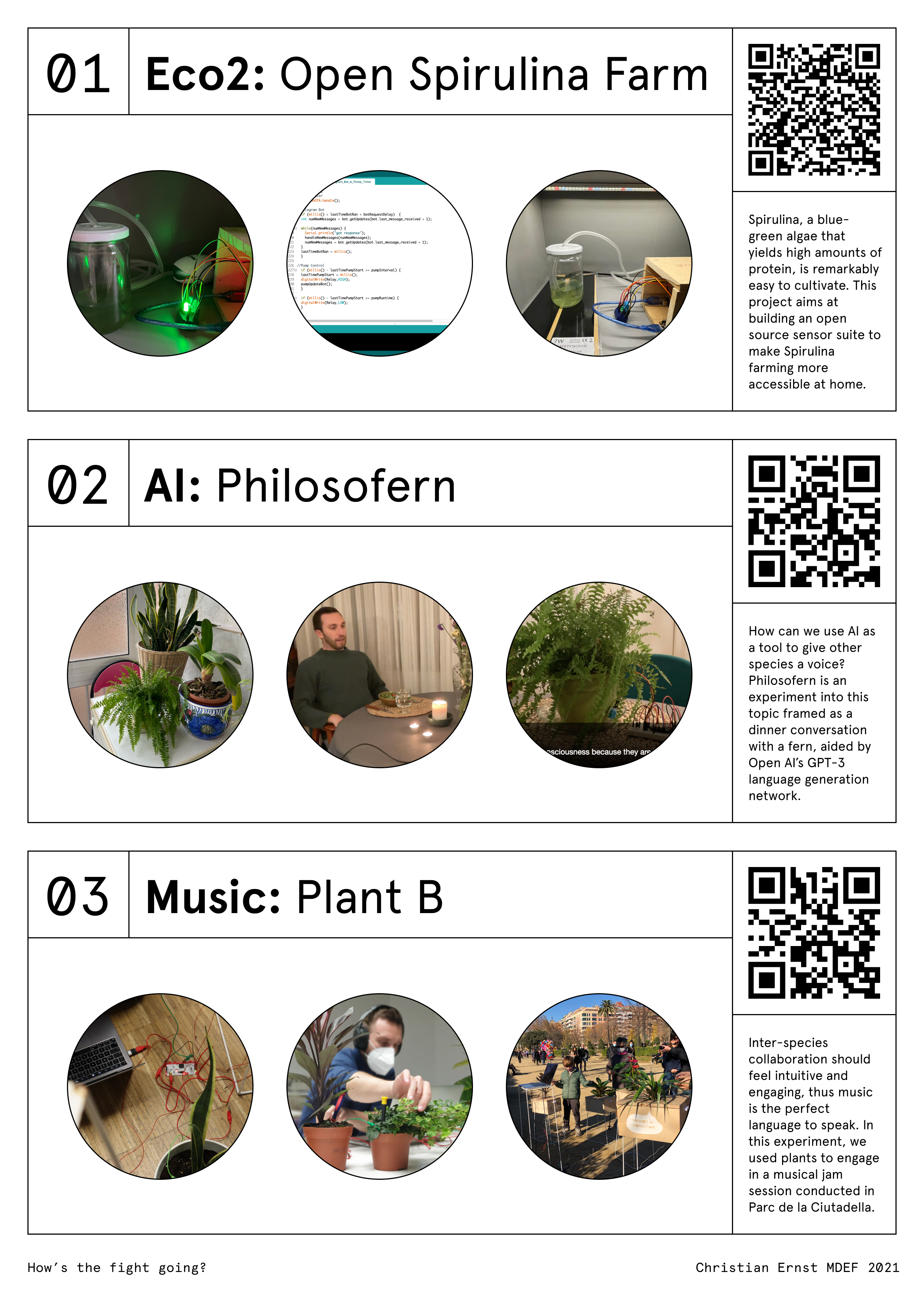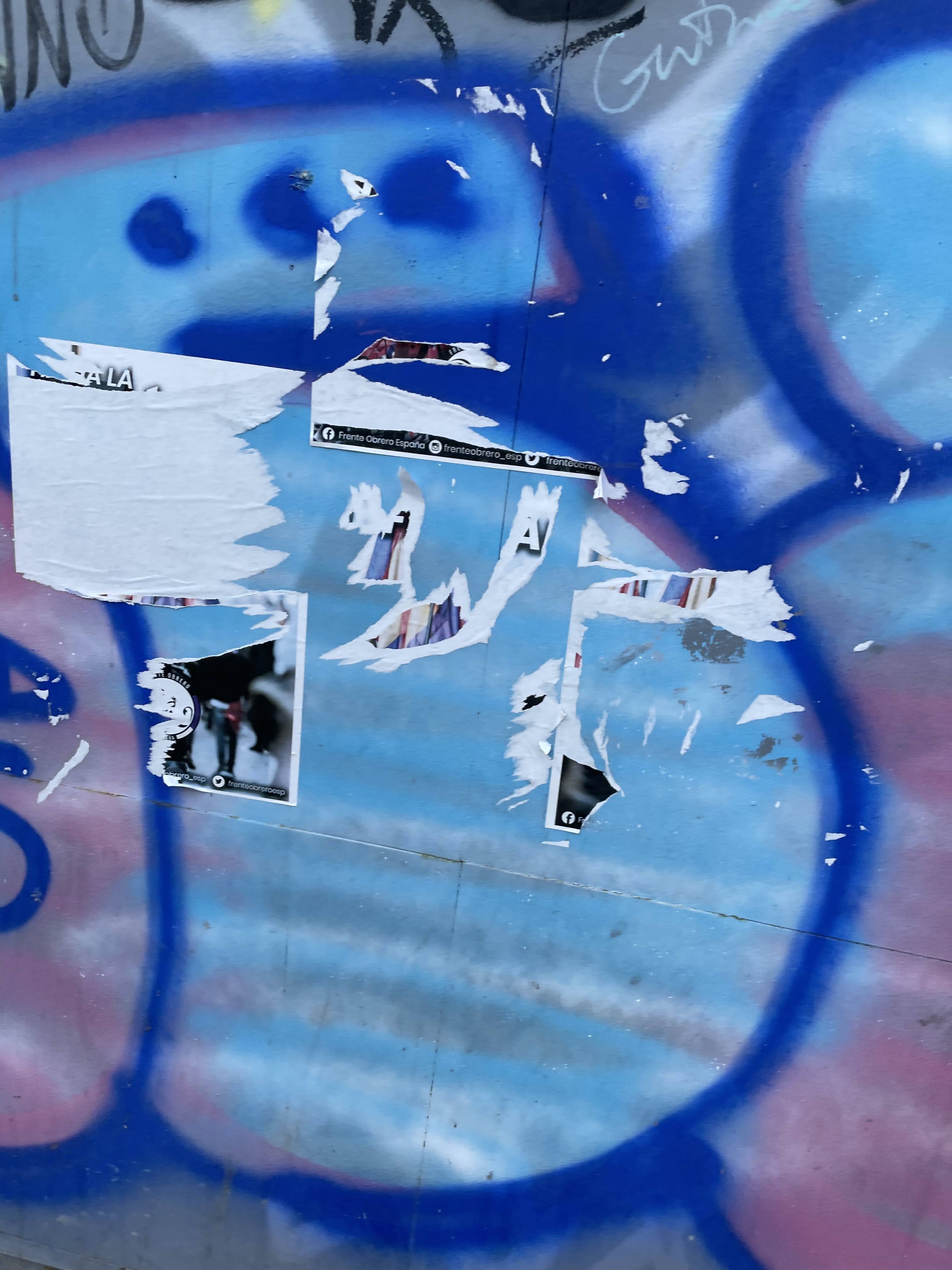Overview
To view term one in retrospective helps to reflect on the possibilities and challenges offered, the personal goals set and the professional growth achieved. It becomes clear that, through offering a broad range of inspirations, this first term opened my eyes metaphorically to not only one but three new categories of applied design, all of which are interconnected. Besides visual design or user experience design, both which I practiced in the past, I now had the chance to discover what it means to use design to build machines and products, to use design to build speculative prototypes, which often share many characteristics with art, and how ethical design and open programming are closely related and dependent on each other. Combined with the early intro to fabrication, which will be extended in the coming term two, an understanding begins to form what 'from bits to atoms and from atoms to bits' could truly mean. This, of course, is not purely limited to inorganic matter, such as 3D printed PLA, but it explicitly extends to organic matter as well. This is where an incredible potential lies in my eyes: Using technology to help mend our broken relationship with nature.
My Fight 2.0
But first, let's look into how the 'my fight' ideas evolved and if any of the objectives were reached:

The updated poster shows the same layout as the original one, with the same identical categories: Eco2 (Ecology and Economy), AI and Music. This version, however, relates one experiment to each of the topics.
Eco2
Spirulina, a blue-green algae that yields high amounts of protein, is remarkably easy to cultivate. This project aims at building an open source sensor suite to make Spirulina farming more accessible at home.
Identifying the key technical and economic challenges of enabling home-based Spirulina farming for mainstream adoption was the primer for this project. In order to be ‘the food of the future’, it has to be accessible to grow for everyone, with knowledge about it distributed in an open manner. This is why a truly open, libre and free technical setup, which could be produced in FabLabs anywhere and which could be adopted for various sizes and climates is one of the most promising approaches for a decentralized solution. This is the economic reasoning behind starting the project. In the same sense, it’s an ecological one, too: By raising attention to the potentials of Spirulina farming and its product’s consumption, we have the chance to also advocate for a far less resource-intensive, plant based alternative to animal products.
AI
How can we use AI as a tool to give other species a voice? Philosofern is an experiment into this topic framed as a dinner conversation with a fern, aided by Open AI’s GPT-3 language generation network.
This was the first experiment of this term with a distinct prototype investigating inter-species collaboration, more specifically a voice-based human-plant-interaction. For me it embodied many challenges I was planning to tackle. It used a Telegram Bot to enable a chat conversation and dealt with giving non-human entities a voice. But most importantly, it allowed me to explore the possible potentials and limitations of OpenAI’s GPT-3 natural language generation network.
Music
Inter-species collaboration should feel intuitive and engaging, thus music is the perfect language to speak. In this experiment, we used plants to engage in a musical jam session conducted in Parc de la Ciutadella.
For the final intervention we took music as a topic and medium and put it in the center of an experiment into collaboration between humans and plants. Collaborating with two fellow musicians, we brought enough to the table to make the regulating collaborative jam session feel natural and organic. It highlighted how effortless and natural it feels for people to touch and empathize with plants, only that there needs to be a formal justification to do it. This for me was the natural progression of experimenting within term one, as it combined many topics to become a successful intervention: Electronics, fabrication, design presentation, plants and finally – music.
New Insights and Methods learned
The Importance of Playful Experimentation
One of the most crucial learnings from the first three months of MDEF studies is to embrace playful experimentation as means of inquiry. Being process-oriented rather than goal-focused, this exploration allows for common themes to emerge organically. Which for me they certainly did (more below). This has been an important lesson in embracing uncertainty and putting oneself out there.
The Importance of Writing as a reflection tool
My second stand-out learning is to revalue the importance of writing as a designer. It serves as a reflection tool, allowing to document progress over results. This is remarkable in an industry where high-polish mockups and UI screenshots are celebrated above anything else. For me, it was important to understand the value that this constant writing can provide, as it is both reflection and documentation at the same time. Finally, publish and let your ideas be read by other people. This is often the start of symbiotic collaborations and dialogues.
The Importance of assuming a First-person-perspective
The third and final learning I‘d like to highlight is using and adding a first-person-perspective to my professional tool belt. This can be crucial to find personal motivations and interests as a driver for design projects and deliver a unique subjective reflection on the topic at hand. Unlike in the free market, where project goals are often pre-determined by clients, using a first-person-perspective in the academic world grants a unique lens into the subjective world of a design problem. Seen through the perspective of the designer, this can allow for many unforeseen and surprising angles on both problems and solutions.
Iterative Prototyping as Spirale Development
Another interesting contextualization of the experiments is to visualize it as spiral development. This shows, to some degree, that all the efforts made within the first term are strongly relating to each other, as they play in a shared contextual field. The inform each other, they form strange symbiosis and magnify each other’s potentials. By reflecting on the first term’s experiments that way, a possible leading idea can be isolated, which is shared amongst all projects.

Illustrating this year's experiments in a spiral development context.
The Leading Idea
This core idea revolves around our relationship with nature, while being part of it, and how technology could help mend this broken relationship. By default, this relationship is symbiotic. However throughout the course of the last centuries, we managed to turn it into a one-sided, dysfunctional and rather abusive relationship. It could go for like this for many centuries more if it weren't for the simple fact that we are not exclusive from the system we're tampering with, but we're part of it. Guided by the misconception, that we, as humans, did somehow rise from our modest evolutionary origins as animals and ascend to something higher, we are disregarding and exploiting the interlinked ecosystem we stem from and are embedded within.
But if the reason for this tragedy lies (in the western world) in our culturally-fueled inflated sense of self as a species, is there a chance it can be healed by invoking empathy for others organisms? May the answer be to foster inter-species collaboration in order to perceive other animals or plants as equal kin, rather than subordinates? The answer is complex, however one thing can be said with certainty: We, as humans, have a much harder time empathizing with organisms we cannot communicate with. This has been the major hurdle for understanding and thus, empathizing with all parts of nature and arguably, animals that developed a shared communication protocol, receive more attention and protection (e.g. dogs).
However, therein lies a massive potential. If organisms are unable to communicate in a shared protocol with us, be it through sound, touch or voice, can technology jump in as a translator? Can a machine learning text-generation network be an advocate for animal rights? Can a chatbot be a representative surrogate for a plant? Can a microcontroller communicate the health status to be the voice for an algae colony? Looking at the experiments conducted in the past quarter, I would argue, yes. Technology has the potential to act as an empathy machine. Thus, I am fascinated by the idea of bewitching or enchanting organisms that traditionally have never had a voice to make them able to speak for themselves, to be perceived as emancipated and equal. In this metaphor, technology acts like a magic wand as it can bring the illusion of intelligence for any species, setting, goal or language we choose. This is a fascinating idea, because, put bluntly, it doesn't need much to fool us as humans. We're just mere animals after all.
